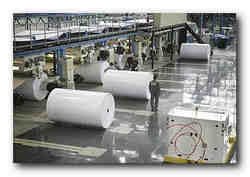 The WWF Environmental Paper Company Index (EPCI) 2015 shows a positive trend towards more transparency and sustainability by the world’s more progressive pulp and paper manufacturers. The 31 voluntary participants in this year´s Index together produce 15% of the world´s paper and board and 15% of the world´s pulp. While all participating manufacturers demonstrated outstanding transparency, more than 90% of product categories reported since 2013 showed improvement.
The WWF Environmental Paper Company Index (EPCI) 2015 shows a positive trend towards more transparency and sustainability by the world’s more progressive pulp and paper manufacturers. The 31 voluntary participants in this year´s Index together produce 15% of the world´s paper and board and 15% of the world´s pulp. While all participating manufacturers demonstrated outstanding transparency, more than 90% of product categories reported since 2013 showed improvement.
“The pulp and paper industry has the potential to contribute to a greener economy. The EPCI 2015 signals progress in that direction, at least by the industry’s most transparent companies,” says Emmanuelle Neyroumande, Pulp and Paper Global Manager at WWF International.
The 31 companies participating in EPCI 2015, up from 25 in 2013, disclosed the ecological footprint of 85 million tonnes of pulp and paper. This represents 30% of the world´s tissue, 28% of the world´s graphic paper, 16% of the world´s newsprint, 7% of the world´s packaging and 15% of the world´s pulp.
The EPCI 2015 participants showing leadership in transparency are (in alphabetical order) Appleton Coated, ARAUCO, Arjowiggins Graphic, BillerudKorsnäs, Bio-PAPPEL, Canfor Pulp, Cascades, Catalyst, CMPC, Crown van Gelder, Domtar, DS Smith, Fedrigoni, Fibria, ITC, Kimberly Clark, Klabin, Lecta, Leipa, Metsä Group, Mondi, Resolute Forest Products, Rolland Enterprises Inc., SCA, Södra Cell, Sofidel, Steinbeis, Stora Enso, Suzano, TNPL/India, UPM. Access the results of the 31 participants on www.panda.org/epci2015
.
The EPCI is based on voluntary data disclosure by the companies. WWF evaluated environmental policies and targets as well as environmental performance in the production of newsprint, graphic paper, tissue, packaging and pulp. Scores were assigned on responsible sourcing, clean production, Environmental Management Systems and reporting. The Index also shows progress between 2013 and 2015 for companies that have participated in both of those years.
“Of the 80 major manufacturers invited to the EPCI 2015, 31 participated, some already for the fourth time. We invite those who declined this year to get more familiar with the tool and to join the next EPCI 2017,” says Neyroumande.
Companies who participated in the EPCI 2013 were able to increase their overall scores on more than 90% of product categories. The product category in most need for improvement is pulp, which tends to show generally lower scores than other products.
WWF’s Living Forests Report projects paper production and consumption may double in the next three decades, and overall wood consumption may triple.The key challenge for forest-based industries is how to supply more wood products with less impact on nature. This challenge spans the whole supply chain, from where and how wood is grown and harvested to how wisely and efficiently it is processed, used and reused.
“The pulp and paper sector has unique potential to supply renewable materials that help do things as diverse as share knowledge, improve sanitation and keep food safe. However, this potential is diminished if poor logging practices degrade forests and deplete carbon stores, if plantations take land away from traditional communities, if dirty pulp mills pollute air and water or if paper fit for recycling is dumped or burned. The EPCI helps us assess if industry is making good on its promise of supplying essential products with reduced impact on nature,” says Rod Taylor, Director of WWF’s Global Forest Programme.
Friday, 06 November 2015 09:44
WWF´s Environmental Paper Company Index shows continual improvement by leading pulp and paper producers
Written by Ianadmin
Published in
European News
Tagged under
Latest from Ianadmin
- Valmet strengthens its presence in Asia Pacific by opening new service center in Indonesia
- Arjowiggins campaign showcases vibrant colour capabilities of cyclus offset
- Metsä Board celebrates winners in 2017 European Carton Excellence Awards
- Valmet's new scanner for converting lines lifts process control to a new level
- International Paper to Convert Riverdale Paper Machine
